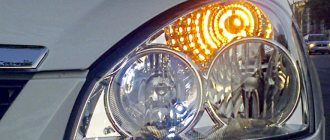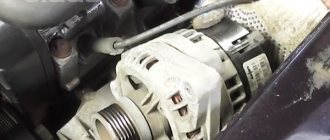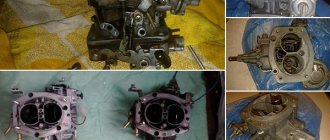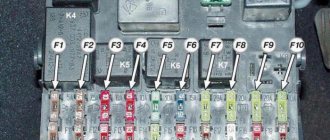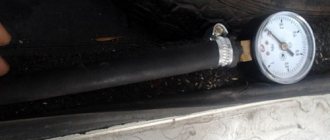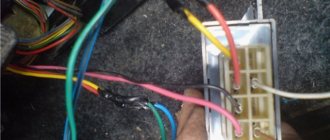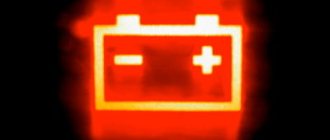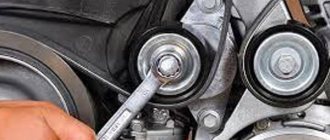Some car malfunctions have a characteristic sound, due to which they can be diagnosed and then eliminated. One of the most well-known problems that even an inexperienced driver can diagnose by sound is a faulty alternator belt. There is an opinion that if the alternator belt whistles, it needs to be changed immediately, but this is not at all true. There are many reasons why the alternator belt whistles, and the unpleasant sound from under the hood is not always associated with a malfunction of this element. Before you start replacing the alternator belt, it is better to diagnose the problem and, if possible, fix it.
Why does the alternator belt whistle: the main reasons
If you understand the technical features of a car engine, you can understand that the alternator belt is not tasked with the most difficult tasks. It is necessary to transmit rotation from the crankshaft to the generator rotor, thereby allowing it to generate electrical energy and distribute it among consumers, including charging the battery. To connect the crankshaft and the generator rotor to each other, not only a belt is used, but also pulleys on which it is directly put. Most often, the cause of a whistling alternator belt should be found in the pulley.
As you might guess, the whistling of the alternator belt occurs due to unintended friction of parts against each other. If we specify the problem, we can reveal that the main reasons for the generator belt whistling are as follows:
- Various liquids have come into contact with the alternator pulley or belt: oil, coolant, gasoline or other;
- The belt is excessively worn, and even re-tensioning it does not always solve the problem;
- The belt is made of low quality materials. Often the surface of “Chinese” alternator belts is not covered with the same material from which it is made inside. When the outer layer wears off, a whistling sound begins.
It is also worth noting that the belt can whistle due to a malfunction of the generator itself, for example, if the bearings are heavily worn. In such situations, it is necessary to replace the generator or repair it.
A whistling sound is heard when starting the engine
Let's start with the fact that a distinct whistle or short-term squeak can appear even on a new car when the engine is started. This often happens in wet weather. After a few seconds the sound disappears. There may be no other symptoms of a malfunction. Also, this kind of whistle is constant, and as the engine speed increases, the whistle begins to get louder. In both cases, a common cause of noise is the attachment drive or drive belt. Most often, a quiet or shrill whistle, depending on the design features, is produced by:
- alternator drive belt;
- power steering (power steering);
- air conditioner drive;
- coolant pump drive;
It must be added that both the drive belts themselves and the bearings in the specified equipment can whistle. Also, extraneous sound occurs as a result of wear on the surface of the pulleys or the ingress of dirt.
Alternator belt whistles when cold
The generator whistle has its own varieties, and sometimes it can appear when the engine starts, and then disappear. Most often, such situations arise at low temperatures, and it is said that the alternator belt whistles when cold. This problem is very easy to diagnose - after the engine warms up, the unpleasant sound disappears.
The reason for the whistling of the alternator belt on a cold engine is its slipping. The torque transmitted from the crankshaft is not sufficient to spin the generator pulley, and there may be several reasons for this:
Incorrect lubricant for the generator bearing. Due to the compaction of its consistency in cold weather, the alternator pulley will not be able to rotate properly until the engine warms up, which in turn will “unfreeze” the lubricant, and the whistling noise will stop in this situation. The obvious solution to the problem is to replace the lubricant with a more temperature-resistant option.- The alternator belt is loose. Here the situation is similar, until the car engine begins to work dynamically, a poorly tensioned alternator belt will not be able to “accelerate” on the pulley, and a whistle will be heard when it slips.
Please note that the generator belt can whistle when cold when there is a serious problem with the generator - a jammed pulley. You can diagnose this problem yourself by trying to rotate the generator pulley. If it doesn't spin at all, the alternator will need major repairs or replacement.
Other reasons
The noise can also come from a broken seat and a worn shaft.
Of course, the generator can also make noise due to a short circuit.
The timing belt may hum, and the owner may think it is a generator. In this case, you need to remove the belt and listen - if the noise disappears, then it was the belt.
For many Russian drivers, the generator begins to hum after heavy rain. This means that water gets inside the unit, and until you disassemble the element and clean everything inside, nothing will help.
And of course, a relay or integral. Brushes cost pennies, so to check, it is advisable to change them first. Then listen to see if there is a hum.
Thus, the generator can hum for various reasons, but the most common are: bearing failure, a short circuit in the diode bridge, or a wire falling off.
- Absolutely legal (Article 12.2);
- Hides from photo and video recording;
- Suitable for all cars;
- Works through the cigarette lighter connector;
- Does not cause interference to radios and cell phones.
Alternator belt whistles when under load
If the alternator belt whistles not only when the engine starts, but also when the car is running, it is not at all necessary to change it immediately. Carry out the following procedures to correct the situation:
Remove the alternator belt completely from the car and inspect it for wear;- Next, make sure that the belt is clean - there are no automotive fluids on it, since even one drop of oil or antifreeze will cause it to whistle during operation;
- Check how well the generator pulley rotates;
- Reinstall the belt and make sure it is tensioned correctly;
- Try starting the engine again and listening to the car for a whistle.
In most cases, the whistling of the alternator belt is associated with poor belt tension.
Flew off, torn - what will be the consequences?
At the very beginning, I want to answer - what happens if the alternator belt comes off? A very common question for my website and channel. EVERYTHING IS SIMPLE – NOTHING WILL HAPPEN ! Often, a belt drive turns not only the generating unit, but also other units, for example a power steering pump, or an air conditioning pump, etc.
If it falls off or breaks, then nothing bad will happen! Perhaps the power steering and air conditioning will stop working and electricity will be generated, that is, the battery light will be on.
Is it possible to go? Yes, you can, but NOT ADVISABLE! Because the battery will be discharged, the entire load will go to it, it will give up its charge to the ignition system and fuel pumping, and how long it will last is DIFFICULT TO PREDICT! Because the condition of the batteries is different for everyone.
The power steering will not work, that is, the steering wheel will become stiff and it will be very difficult to turn it.
The air conditioning unit or climate control will not work, but this is not so critical here; I would definitely not turn it on if the belt was torn or fallen off!
In general, the conclusion is this: nothing terrible will happen, but you can’t drive for a long time! Only to the nearest station, where the belt drive will be restored again. However, there will be no global breakdown!!! This is not a timing system , everything could be much worse there
Many people ask, if it whistles, does that mean you need to take a new one with you? YES, not always, it happens trivially, the pulleys are dirty or worn out, but more on that a little later.
Liquid for increasing the elasticity of the alternator belt
In car stores you can find many different “chemicals”, among which there is a special product for generator belts. Most often it is performed in the form of an aerosol, and its purpose is to protect the belt from cracking and increase its elasticity. Such products really have a beneficial effect on the alternator belt, and in many cases (with increased wear or poor belt tension) they allow you to get rid of its whistling.
Manufacturers of generator belt fluids recommend applying their products not only when the whistle appears, but also for preventive purposes earlier, to increase the service life of the element. Some packages with such “chemistry” indicate that it can double the service life of the alternator belt with regular use.
( 424 votes, average: 4.48 out of 5)
Oil in the air filter: why it gets there and what to do
Repairing a torpedo after the airbags deployed
Related Posts
Basic faults
A whistle is already a malfunction - there are not many of them in this unit. You have to say “heater” - either it works or it doesn’t. If the stove does not blow at all, this means the electric motor is jammed or the brushes are worn out. If you were still skating with a bang, and then at one point it disappeared, and the heater stopped working, then it’s definitely an engine failure, most likely the problem is in the bearing or bushings.
Therefore, in 70% of cases, lubrication really helps, but if you have been driving for a long time with noise, it is possible that the bearing is already worn out. Therefore, as soon as noise appears, crackling and so on, we disassemble the stove and clean it. What else I would like to note on our VAZs, especially on the “classics”, bushings were used instead of bearings; after they were worn out, they needed to be replaced, however, many craftsmen still install bearings on the VAZ heater - I think this is correct!
Clutch is a frequent source of whistles and rattles
A slipping clutch is a fairly common problem in modern cars. Our mode of operation of transport is quite complicated; cars have a hard time in cities. It is the clutch that especially suffers from urban travel, as it constantly overheats and is forced to suffer from continuous use. Clutch problems are difficult to fix on your own, but you can identify them as follows:
The clutch will have to be repaired at a service station. Even with some experience in plumbing, it is very difficult to understand modern clutch and gearbox systems. Therefore, it is easier to entrust the work to specialists and not waste your time. The most reasonable solution for domestic cars is to replace the complete clutch. For many modern foreign cars, this process will be too expensive and require huge expenses. So the owner will have to make a decision based on the budget.
Source
Possible repairs
What to do in this situation? The solution depends on the identified malfunction. A loose drive should be tightened. Kalina cars and other front-wheel drive VAZA models have a tension bolt that allows you to adjust the degree of belt tension.
To carry out the manipulation, loosen the fastening bolts, then tighten the adjustment bolt a few turns, achieving optimal tension. A correctly tensioned drive should bend no more than 1 cm under hand pressure. If this cannot be achieved even with the bolt tightened to maximum, the belt should be replaced.
If the pulleys become oily, the drive should be removed and the inside should be wiped with alcohol or gasoline. Pulleys are cleaned in the same way. If the belt has been in an oily state for a long time, it is recommended to replace it, since fuels and lubricants destroy rubber. Also, current seals and gaskets must be changed.
In cases where the alternator belt whistles “when cold,” repair is not required. It is permissible to slightly increase the belt tension. However, if the whistling noise disappears after warming up, this is not necessary.
If, as a result of diagnostics, it was revealed that the front bearing of the generator is whistling, it is replaced. To do this, remove the unit from the car, dismantle the front cover and, after removing the faulty bearing, press in a new one. This is also done when the pulley is skewed and the generator shaft is jammed.
Starter
There are several reasons for this behavior. In order to understand the reasons in more detail, you need to know the starter design and operating principle. It consists of an electric motor, on the shaft of which an overrunning clutch with a drive gear is installed. In everyday life, the clutch and gear are called bendix. The design also includes a starting relay with a solenoid. This design is called a “traction relay”. It is connected to the clutch by the starter activation lever.
This design works as follows
. When turned on, the electric motor begins to rotate the bendix. At the same time, the traction relay, having activated, moves the overrunning clutch forward using a lever.
As a result, the gear meshes with the teeth of the flywheel and spins the engine. After the engine starts, the overrunning clutch is activated. This protects the starter from damage. When the current supply to the device is turned off, the relay stops working and returns to its original position. Passenger car starters usually use a roller-type overrunning clutch.
There is only one reason for the grinding noise at startup. For some reason the Bendix cannot fully engage the flywheel. Therefore, when starting the starter, a grinding sound of skipping teeth occurs. This problem needs to be fixed as quickly as possible. Otherwise, the flywheel and starter gears may be damaged. You need to check the following points:
- First, check the starter mounting. Sometimes vibration can cause the mounting bolts to come loose. In this case, the starter becomes warped and the gear loses full contact with the flywheel. In any case, remove the starter and check the condition of the bendix;
- Sometimes the problem can be caused by gear wear. In this case, the starter's performance decreases. When starting the engine, you will hear the grinding sound of the bendix moving around. Over time, the starter will not be able to turn the flywheel at all. After removing the part from the machine, you can see the gear wear with the naked eye;
- Sometimes the Bendix does not move well along the shaft and simply does not reach the flywheel. In this case, remove it. You need to anoint the shaft with any motor oil (or whatever you have on hand). Also check the operation of the traction relay.
These are the main causes of a grinding noise at startup associated with this particular part.
Most often you will find . A crackling sound when starting can also occur due to problems with the starter's power supply. It appears when the positive wire is loosened. If there is poor contact, a spark discharge occurs, which is what produces a crackling sound. Check the wire. Tighten it if necessary.
Flywheel
. The cause of the grinding noise may be in the engine. If the flywheel teeth are worn too much, they cannot form full contact with the starter gear. As a result, you can hear an unpleasant grinding noise. It is advisable to replace the flywheel. Otherwise, wear on the bendix will increase and you will have to change it regularly.
Since we're talking about the flywheel, read our two materials on this topic.
Engine grinding when starting is quite common, especially for older cars. But this malfunction did not bypass new vehicles either. The occurrence of this problem is associated with the failure of one or more elements in the motor.
How to deal with this?
Now let's talk about methods to solve the problem. Many vehicle owners are interested in the question - how to eliminate the whistling of the alternator belt in their car, which appears when starting the engine? We will try to explain the essence of the solution to the problem as clearly as possible. Below are methods that will allow you to overcome the problem.
Replacing the strap
To change an element, you need to loosen its tension. In most vehicles, the tension mechanism is adjusted using a bolt or a semicircular adjuster. To begin with, you should study how the component is positioned and what it is hooked onto in order to understand how to remove it. Our resource provides practical instructions for replacing the alternator belt - study them, perhaps you can find something for yourself. It should be noted that the new strap must be installed in exactly the same way as the old one.
Using a wrench, loosen the tension screw until the element can be simply removed. When this happens, remove the strap and replace it with a new one. It is advisable to know how long the new part should be tightened.
Removing dirt
If the strap is too dirty and whistles when starting for this very reason, then the element will also have to be dismantled. Loosen the tension screw and remove the strap. Wipe all sides dry so that there is not even a hint of grease on it. You can use acetone to make it more effective. Also, do not forget to wipe all the pulleys on which the belt is installed; it is quite possible that some of the lubricant got there too.
If there is sagging
This problem is also not particularly difficult to solve. You need to open the hood and check the mechanism. If a component sags even a little, then you need to tighten it; we discussed how to do this above. In addition, pay attention to all the pulleys: they must be located in the same line relative to each other, if this is not the case, then the shafts must be aligned in the right order. Check the technical documentation for the vehicle, it will help you understand this issue.
Sorry, there are no surveys available at this time.
If the strap is too tight
In this case, its position will also need to be adjusted, just not tightened, but loosened. If the starting whistling does not occur in wet weather, but in winter, then this problem usually corrects itself. That is, when the car warms up to the desired temperature, the strap expands slightly, which eliminates the whistling problem.
Bearing replacement
If a part is worn out, then there is only one way out - to replace it with a new one. If everything is fine with the belt itself and there are no signs of deformation on it, then spend time on the secondary components of the system. In this case, you can simply visually diagnose the bearings that affect the operation of the device. There should be no problems with this procedure - a worn part can be easily replaced with a new one by dismantling and installing. We hope that our recommendations will help you solve this problem. And remember - the problem of whistling does not always lie in the belt itself!
Before you begin repair work, it is important to correctly assess your strengths. Before performing the procedures for dismantling and installing the timing belt, it is important to thoroughly familiarize yourself with its structure so that subsequent installation is carried out correctly. If you are not sure of the correctness of your actions, then check the vehicle’s operating manual. At worst, you can always turn to a mechanic at a service station for help.
Conclusion
Grinding and crackling noises in the power unit indicate that some engine parts have failed. So, the grinding noise is accompanied by a malfunction in the starter or flywheel. As for the crackling sound, the situation is much more complicated - most likely the problem is hidden in the crank mechanism or in the cylinder head.
Even an inexperienced car enthusiast will say that the main unit in any vehicle is the internal combustion engine. If a malfunction occurs in the operation of this unit, the driver will know about it immediately by the behavior of the car. One of the common problems in engine operation is the appearance of extraneous sounds. Why you hear a whistle and what to do in this case - this material will help you understand the problem in detail.
[Hide]
Elimination methods
A squealing belt is perhaps the only reason why a whistle may occur when starting the engine. This means that the drive element has stretched and is slipping along the pulley.
So, this significantly increases the wear of the belt itself, which will inevitably lead to tragedy in the power unit, unless, of course, the situation is corrected in time. Let's consider repair and diagnostic operations to eliminate whistling in the engine.
Timing drive
A whistling sound in the engine caused by a faulty timing belt is more than an urgent repair. If the part is not replaced in time, this will lead to a break in the drive, and at the same time to bent valves, which inevitably leads to costs.
The average, even the best belt should be changed no later than 70,000 km. Typically, car manufacturers indicate the maintenance interval for the timing belt unit in technical documentation and service books. In any case, the motorist must monitor the condition of the components and parts of the engine of his vehicle.
To determine the condition of the timing belt, it is necessary to remove the protective timing cover. Next, you should unscrew the tensioner and inspect the drive. The belt should not have cracks, burrs or other phenomena that will inevitably lead to rupture.
Also, it is worth noting that the tension of the element is very important, since a belt that is too tight is a heavy drive, which increases wear on the rubber-metal part.
With low tension, the part will slide, thereby causing a whistle. But, in modern vehicles, timing belts are used, which whistle when worn heavily.
Attachment Drive Belts
In this case the situation is still the same. Belt slippage causes a whistling sound when starting. In this case, the whistle may disappear after some time of operation. But you shouldn’t get your hopes up, because the spare part needs to be replaced as soon as possible.
Another cause of whistling, in rare cases, may be a malfunction of the water pump or drive pulleys. So, the pump has a bearing installed, which wears out over time. So, a coolant leak may form from under this element, which is quite difficult to notice, especially if it is dripping.
Thus, the production of an element can rotate it, after which the metal rubs against another metal, which leads to the formation of sound. As you know, after heating the elements expand, so the bearing, when it heated up during operation, expanded and stopped turning in the mounting location.
Deformation of the drive pulleys can also cause noise and whistling, since the belt slips in one place and cannot engage properly. The worst thing is if the resulting deformation causes the drive belt to rub against other parts.

